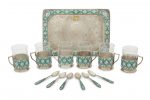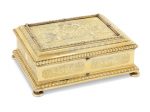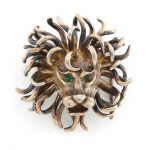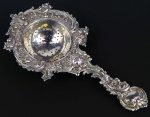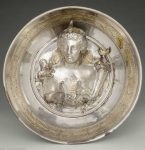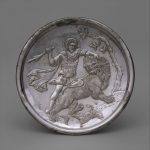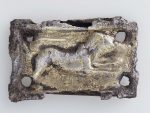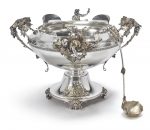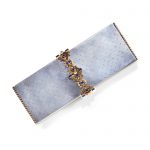Lions have a long history in Art and Design. They have been found depicted on coins as far back as 480BC, possibly earlier. They were an important part of Roman history and other cultures. Below are some examples of lions depicted in silver.
A Persian etched glass and enameled silver seven piece tea service 20th century Comprising: six cups, six spoons, a serving tray with a gilt Iranian Lion and Sun emblem applied to the interior surface, and an accompanying letter from former Prime Minister of Iran Amir-Abbas Hoveyda; length of tray 13in (33cm); width 9in (23cm).
Sold for US$ 4,750 (£ 3,666) inc. premium at Bonhams in 2018
Silver coin.(obverse) Forepart of lion right. (reverse) Rear of lion right; in incuse square. 480BC-460BC (circa)
Reference: © The Trustees of the British Museum
A WILLIAM III SILVER-GILT CASKET MARK OF PIERRE HARACHE I, LONDON, 1695 Oblong and on four bun feet, with gadrooned borders, the sides with finely engraved panels depicting, on the front, a putto in scrolling foliage, on the sides military trophies and on the back a putto holding a cypher beneath a coronet, the hinged cover engraved with a cypher within a lozenge shaped cartouche and with coronet above, supported by a putto and with lions below, all surrounded by scrolling foliage on a matted ground, marked underneath, inside cover, on internal frame and plaque, further engraved underneath with a scratch weight ’91:9′ 10 ½ in. (16.5 cm.) wide 92 oz. (2,862 gr.)
Sold for GBP 175,000 at Christies in 2018
Gold-Plated Silver Lion Head Belt Buckle Signature obscured, ap. 81.6 dwts.
Sold for $437 (includes buyer’s premium) at Doyle New York in 2019
A lovely English sterling silver repousse handled tea strainer having a scrolled design and lion bust. Partial impressed marks to side. No apparent monograms or removals. Measures approx. 6 7/8″ long x 3 3/8″ width(17.5cm x 8.6cm). Total weight approx. 79.2 grams / 2.55ozt.
Sold for $125 at ELITE AUCTIONEERS LLC in 2019
The originality and exceptional quality of this emblema dish make it one of the most important items of the silver treasure discovered in 1895 at Boscoreale, in a Roman villa buried by the eruption of Vesuvius in AD 79. The female bust in the center wears an elephant hide and is accompanied by a profusion of symbols whose interpretation remains uncertain: perhaps a portrait of Cleopatra, or her daughter, or an allegorical personification of Africa or Alexandria?
Reference:The Louvre
Plate with David Slaying a Lion circa 629–630 Made in Constantinople Byzantine Silver
In 628–29 the Byzantine emperor Herakleios (r. 610–41) successfully ended a long, costly war with Persia and regained Jerusalem, Egypt, and other Byzantine territory. Silver stamps dating to 613–29/30 on the reverse of these masterpieces place their manufacture in Herakleios’s reign. The biblical figures on the plates wear the costume of the early Byzantine court, suggesting to the viewer that, like Saul and David, the Byzantine emperor was a ruler chosen by God. Elaborate dishes used for display at banquets were common in the late Roman and early Byzantine world; generally decorated with classical themes, these objects conveyed wealth, social status, and learning. This set of silver plates may be the earliest surviving example of the use of biblical scenes for such displays. Their intended arrangement may have closely followed the biblical order of the events, and their display may have conformed to the shape of a Christogram, or monogram for the name of Christ. In order to prove that he can kill Goliath, David describes to Saul how he killed a lion (1 Samuel 17:34–37). The accomplished naturalism of David’s flowing cape and the lion’s fur and mane demonstrates a conscious reference to and continuity of the traditions of Greco-Roman art.
Reference: The Metropolitan Museum of Art
Silver horse trappings Nubian Meroitic Period, reign of King Amanitaraqide 40–A.D. 50
Rectangular horse harness plaque with figure of lion, bounding right; abraded. Gilt Silver with bronze back-plate.
Reference: Museum of Fine Arts Boston
AN AMERICAN SILVER PUNCH BOWL AND LADLE, GORHAM MFG. CO., PROVIDENCE, RI, RETAILED BY STARR & MARCUS, NY, 1871 the base with lions and four scroll feet headed by lion masks, the bowl monogrammed HM and applied at the shoulders with two fully-modeled Bacchic figures with musical instruments, grapevine handles and matching ladle with leaf-form bowl and lion-head terminal. Together with a cane with gold handle, the top monogrammed LWM and engraved at midband Buen Amigo de Nicaragua, 3 pieces marked on bases length over handles 21 in. 53.3 cm 178 oz 5536 g
Sold for 20,000 USD at Sothebys in 2019
